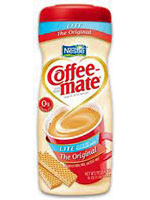 Ingredients
Ingredients- Glucose syrup
- Hydrogenated vegetable fat
- Dipotassium phosphate
- Trisodium citrate
- Sodium caseinate (milk proteins)
- Sodium hexametaphosphate
- Mono- and di-glyceride esters
- Silicon dioxide
- Titanium dioxide
- Riboflavin
Published December 2009
This can be added to coffee and it gives it a sweeter and creamier taste while not cooling it down too much - rather like adding hot milk.
Ingredients
Glucose syrup is produced from maize starch (aka corn starch) by the action of two enzymes. Amylase enzyme breaks the long chains of starch into smaller strands and then glucoamylase chops them into glucose molecules.
Hydrogenated vegetable fat is made from plant oils, such as palm kernel oil or soybean oil by adding hydrogen atoms thereby converting them from a liquid to a solid. Hydrogenation can also form trans fats, in which double bonds have been rearranged, but those in Coffee-Mate are free of trans fat.
Sodium caseinate is also know as milk protein and it contains all the essential amino acids. It is precipitated by adding acid to skimmed milk. Caseinate forms a plastic with formaldehyde and it has been used in adhesives, paints, and textile finishes.
Dipotassium phosphate [aka E340 or K2HPO4] helps prevent Coffee-mate from becoming lumpy. It is made from potassium carbonate and phosphoric acid.
Sodium citrate [aka E331(iii), or trisodium citrate, or C3H5O(CO2Na)3] is an acidity regulator. It is manufactured from molasses by fermenting with the mould Aspergillus niger and is added to formula baby feeds because it prevents milk coagulating into curds; for this reason it used to be added to blood transfusions. It was also prescribed it as a treatment for bladder infections.
Sodium hexametaphosphate [aka E452(i) or (NaPO3)6] also acts as a sequestrant and stabiliser. This consists of six phosphate groups in a ring, and was formerly used as a water softener (Calgon) and in laundry detergents, but is no longer used for these purposes.
Mono and diglycerides [aka E471, E472] act as emulsifiers and thereby ensure that when Coffee-mate is added to coffee its ingredients are dispersed smoothly, and if you want whipped coffee they will produce a stable foam.
Silicon dioxide [aka E551, silica, or SiO2] is another name for sand. Here it comes from the chemical industry and in a pure form. It acts as an anti-caking agent and keeps Coffee-Mate free-flowing. Some plants like nettles actually grow silicon dioxide to make their pointed barbs. Silicon dioxide may be an essential element for humans as it appears to form connective tissue.
Titanium dioxide [aka E171 or TiO2] is a brilliant white pigment used mainly in paints because of its superb covering power - it replaced white lead which was used for centuries.
Riboflavin [aka E101, vitamin B2, or C17H20N4O6] also helps supplement this essential component of the diet which would come from adding milk to coffee. It is produced industrially by fermentation using yeast or bacteria.
Riboflavin, which is orange, and titanium dioxide, which is white, together give Coffee-Mate its creamy colour.